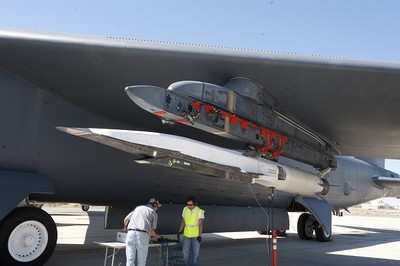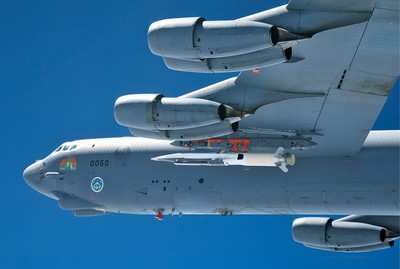Fri, Jun 17, 2011
Scramjet Failed To Develop Full Power
A second test of the X-51A Waverider flew June 13, 2011, in the
Point Mugu Naval Air Test Range over the Pacific Ocean, bringing
significant hypersonic research data in a less than successful
flight test. The hypersonic aircraft was successfully boosted to
just over Mach 5, and the scramjet engine lit but failed to
transition to full power.

Air Force Flight Test Center officials said after a flawless
flight from Edwards Air Force Base, a U.S. Air Force B-52H
Stratofortress released the experimental vehicle from an altitude
of approximately 50,000 feet. After release the X-51A was initially
accelerated by a solid rocket booster to a speed just over Mach
5.
The experimental aircraft's air breathing scramjet engine lit on
ethylene and attempted to transition to JP7 fuel operation when the
vehicle experienced an inlet un-start. The Waverider attempted to
restart and oriented itself to optimize engine start conditions but
was unsuccessful. The vehicle continued in a controlled flight
orientation until it flew into the ocean within the test range.

According to Charlie Brink, the Air Force Research Laboratory's
X-51A program manager, AFRL, Boeing and Pratt-Whitney Rocketdyne
engineers are reviewing the large amount of telemetry data
collected during the test flight to identify the cause of the
anomaly. "Obviously we're disappointed and expected better
results," said Mr. Brink, "but we are very pleased with the data
collected on this flight. I am extremely pleased with the AFFTC and
Point Mugu's support and execution of this complex flight test
mission, as they provided us every opportunity for success in this
endeavor. We have attempted two scramjet experiments now where one
successfully lit, and one did not. We will continue to examine the
data to learn even more about this new technology," he said. "Every
time we test this new and exciting technology, we get that much
closer to success."
Boeing and Pratt-Whitney Rocketdyne built four X-51A flight test
vehicles with the program goal of reaching Mach 6 in hypersonic
flight. The next flight is tentatively schedule for fall 2011.
More News
He Attempted To Restart The Engine Three Times. On The Third Restart Attempt, He Noticed That Flames Were Coming Out From The Right Wing Near The Fuel Cap Analysis: The pilot repor>[...]
Make Sure You NEVER Miss A New Story From Aero-News Network Do you ever feel like you never see posts from a certain person or page on Facebook or Instagram? Here’s how you c>[...]
From 2009 (YouTube Edition): Leading Air Show Performers Give Their Best Advice for Newcomers On December 6th through December 9th, the Paris Las Vegas Hotel hosted over 1,500 air >[...]
Aero Linx: NASA ASRS ASRS captures confidential reports, analyzes the resulting aviation safety data, and disseminates vital information to the aviation community. The ASRS is an i>[...]
“For our inaugural Pylon Racing Seminar in Roswell, we were thrilled to certify 60 pilots across our six closed-course pylon race classes. Not only did this year’s PRS >[...]
 NTSB Final Report: Rutan Long-EZ
NTSB Final Report: Rutan Long-EZ ANN FAQ: Turn On Post Notifications
ANN FAQ: Turn On Post Notifications Classic Aero-TV: ICAS Perspectives - Advice for New Air Show Performers
Classic Aero-TV: ICAS Perspectives - Advice for New Air Show Performers ANN's Daily Aero-Linx (06.28.25)
ANN's Daily Aero-Linx (06.28.25) Aero-News: Quote of the Day (06.28.25)
Aero-News: Quote of the Day (06.28.25)




